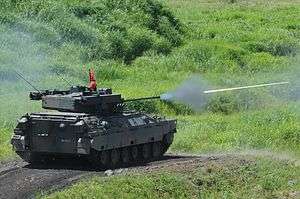Mitsubishi Type 89 IFV
| Mitsubishi Type 89 | |
|---|---|
|
Type 89 shoot Oerlikon 35 mm KDE cannon | |
| Type | Infantry fighting vehicle |
| Place of origin | Japan |
| Service history | |
| In service | 1989–present |
| Used by | Japan |
| Production history | |
| Manufacturer | Komatsu Limited and Mitsubishi Heavy Industries |
| Produced | 1989–present |
| Number built | 120 (2014) |
| Specifications | |
| Weight | 27 tonnes |
| Length | 6.70 m |
| Width | 3.20 m |
| Height |
2.5 m 2.75 m (overall) |
| Crew | 3 + 7 |
|
| |
| Armor | steel ceramic composite armour |
Main armament | 35 mm KDE cannon |
Secondary armament | 2 × Type 79 Jyu-MAT missile, Type 74 7.62 mm coaxial machine gun |
| Engine |
Mitsubishi 6SY31WA Water-cooled 6-cylinder diesel 600 hp at 2,000 rpm |
| Suspension | Torsion bar |
Operational range | 400 km |
| Speed | 70 km/h |
The Mitsubishi Type 89 IFV (三菱89式装甲戦闘車 Mitsubishi 89-shiki sōkō-sentō-sha)(89 FV )is a Japanese infantry fighting vehicle that entered service with the Japan Ground Self-Defense Force in 1989. The vehicle was with 58 vehicles in service as of 1999, with a total of 120 produced by 2014. The main armament of the vehicle is an Oerlikon Contraves 35 millimeter KDE cannon.
Development
Development of the Type 89 began in 1980, with four prototypes being produced in 1984. These prototypes were tested until 1986. It was accepted into service and type classified in 1989. When the vehicle entered production, the initial requirement was for around 300 vehicles. The primary contractor for the project was Mitsubishi Heavy Industries, with the main subcontractor being Komatsu Limited.
Description
The vehicle is of relatively conventional layout with a welded steel hull. The 600 horsepower Mitsubishi 6SY31WA water-cooled diesel engine located in the front left of the hull. It drives an automatic transmission which in turn drives the track via drive sprockets at the front of the hull. On each side of the hull are six road wheels with an idler at the rear, and three track return rollers. The suspension is a torsion bar system. The driver sits to the right of the engine, with a single-piece hatch above him that opens to the right. The driver is provided with three fixed vision periscopes, and a single traversable periscope in the hatch. A passive night vision periscope can be used in place of one of the day periscopes. A single infantry man sits behind the driver and has a hatch immediately above him with two vision periscopes that provide coverage of the front of the hull, as well as a large spherical firing port on the right side of the hull.

In the center of the hull is the two-man turret which mounts the Oerlikon Contraves 35 millimeter caliber dual-feed cannon with a cyclic rate of fire of approximately 200 rounds per minute, which is produced under license in Japan. Coaxially mounted to the cannon is a Type 74 7.62 millimeter caliber machine gun. The turret also mounts a single Type 79 Jyu-MAT missile on each side of the turret. Underneath the missile launcher is an array of three smoke grenade launchers. The gunner sits on the left of the turret, with the commander to his right with hatches that open to the rear. Both are provided with telescopic sights mounted on the front of the turret. The gunner has two vision periscopes that cover the front and left of the turret. The commander has six periscopes that provide all-round coverage. The turret is also fitted with a laser warning system.
At the rear of the hull is the main troop compartment that seats seven infantrymen. The troops enter through two large doors which swing open to the side. The troop compartment has seven firing ports: three on the left, one of the right rear exit door, three on the right side. Each of the firing ports is provided with a vision periscope mounted above it.
See also
- Turkish Tulpar IFV
- Argentinean VCTP
- British Warrior tracked armoured vehicle
- Chinese ZBD97 Type 97
- French Véhicule blindé de combat d'infanterie
- German Schutzenpanzer Marder
- German Schutzenpanzer Puma
- India Abhay IFV
- Italian Dardo IFV
- Russian BMP-3 IFV
- Singaporean Bionix AFV
- South Korean K21
- Spanish Pizarro IFV
- Swedish CV90 IFV
- US M2 Bradley IFV
References
- Jane's Armour and Artillery 2005-2006.
- "89式 装甲戦闘車". rightwing.sakura.ne.jp.
- "89式装甲戦闘車". masdf.com.
- "89式装甲戦闘車". Military Powers.
- "Type 89 Blindé de combat d'infanterie - Armoured infantry fighting vehicle". armyrecognition.com (in French).
External links
| Wikimedia Commons has media related to JGSDF Type 89 (IFV). |

